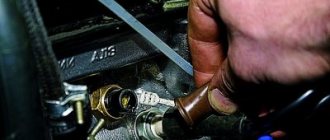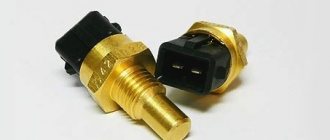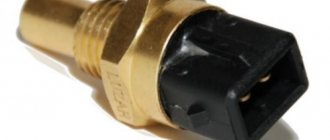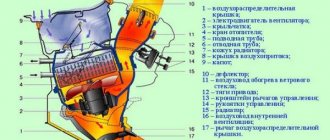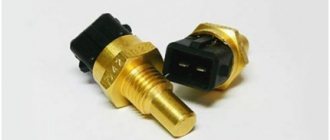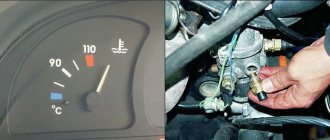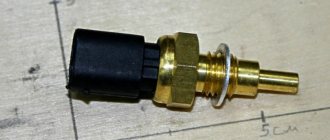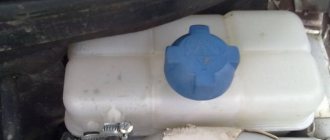Unlike the Lada Priora, the “14th” model is equipped as standard with a coolant temperature sensor (DTOZH) and an outside air temperature sensor (ATNV).
The total number of digital controllers exceeds 10 units. Each of them monitors the behavior of a particular equipment. Sends online to the electronic engine control unit (ECU).
The latter reads the readings, compares them with the programmed data, and if there is a deviation, signals an indicator on the dashboard.
The driver reacts to notifications and decides on the advisability of further use of the technical device.
What temperature sensors are installed on the VAZ 2114
- DTOZH
DTOZH is designed to monitor the temperature of antifreeze in the cooling system circuit of the power unit. After receiving data about the current “degree”, the ECU increases (lowers) the speed of the power unit in order to adjust the temperature.
The quality composition of the fuel mixture depends on the accuracy of the DTOZ readings. The service life of the sensor is unlimited, with the exception of mechanical damage or short circuit in the circuit.
Where it is located: the standard installation location is the outer part of the thermostat housing. The base is screwed into the thermostat body. Two power contacts are connected to the upper part for power supply from the on-board network.
- A melting element is installed inside the DTOZh base. As soon as the antifreeze degree reaches “90”, the contacts close and the on-board computer signals an error.
Next, the driver decides on the advisability of stopping the car immediately, carrying out preventive maintenance, or calling a tow truck.
Catalog articles, prices of temperature sensors for VAZ 2114:
| Name | Catalog item | Price in rubles |
| DTOZH (original), 8 valves, injector | 2115-3811053 | from 350 |
| DTNV (original) | 2115-3828210 2115-3828210-02 2115-3828210-03 | from 350 – 400 |
DTNV
The device is installed in the mounting location of the front bumper, to the left of the center of the radiator grille. The DTOS shape is conical with two contacts on the back side.
The fuse in the mounting block at number 18 is responsible for the operation of the DTOS. Lack of temperature readings on the dashboard is the first sign of equipment failure.
Types of coolant sensors
- Magnetic. Consists of an armature and two coils. The armature is connected to a scale pointer on the car's dashboard. One of the coils is connected to a cable with varying resistance values, and the second to the vehicle network.
- Bimetallic. It consists of a combination of two metal elements with different temperature resistance. Under the influence of heat, expansion occurs, which activates the device on the panel.
- Semiconductor. A more common type of sensor than bimetallic. The operating principle of the device is based on reducing resistance when heated.
- Capillary. Today it is practically not used, as it is considered outdated and not the most convenient type of DTOZH. It is a capsule filled with a substance with a low boiling point. When the engine warms up, the coolant begins to boil, which leads to an increase in pressure in the detector system, as a result of which the indicator needle begins to move.
How to replace it yourself
Preparatory stage:
- Open-end wrench set to “19”;
- Rags;
- Additional lighting as needed;
- New "measuring device".
Replacement algorithm:
- We install the VAZ 2114 in the perimeter of the repair area;
- We turn off the engine, open the hood;
- We provide priority safety measures: block the rear row of wheels with wheel chocks, squeeze the parking brake;
- Remove the terminals from the DTOZH, unscrew the sensor with a key;
- We replace the device with a new one, screw it in, and put on the power terminals again.
We turn the key in the ignition, activate it, and check the functionality of the equipment. Add the missing amount of antifreeze as needed.
DTNV
Sequence of actions when replacing DTOS with your own hands:
- We install the VAZ 2114 on a flat platform, squeeze the parking brake for safety reasons;
- Open the hood and remove the power terminals from the battery. This is necessary in order to prevent short circuits in the circuit during work;
- To the left (right) of the center of the front bumper, the sensor is located on the radiator. Unscrew it;
- We insert a new one into its regular place, screw it on, put on the terminals;
- We assemble the structure in reverse order;
- We put the power terminals on the battery.
After starting the engine, we will check the functionality of the measuring device. Replacement is complete.
Replacement
It is not difficult to replace the DTOZH with your own hands on an injection VAZ 2109. Follow the step-by-step instructions to resolve any issues that may arise.
Removing the device
- First of all, check the condition of the fuses. It is not uncommon for them to burn out, which causes a failure of the coolant temperature sensor.
- Wait until the car has cooled down completely. Under no circumstances should you replace the DTOZH on a hot engine.
- Disconnect the wires going to your DTOZH. You just need to do this in a situation where, when you turn on the ignition, the temperature indicator needle begins to rise sharply and sometimes reaches the maximum level.
- If no changes occur with the arrow, the fault is not with the sensor itself, but with the wire going to it.
- If the needle starts to drop when you turn on the ignition, the coolant temperature sensor has failed and needs to be replaced.
- There is no need to remove half of the units to get to the DTOZH. Access to the device is free, there should be no problems.
- Drain the coolant from the system. This is an excellent reason to at the same time change the antifreeze for a new one, if necessary. If the coolant is fresh, use a clean container to drain it.
- Disconnect the wiring from the sensor.
- Using a socket, unscrew the regulator so that it can be easily removed by hand.
- Clean the device landing area. This usually accumulates a decent amount of dirt and dust, which can cause the new antifreeze temperature sensor to not work correctly.
- To clean, use any rag that does not leave behind lint or threads.
- Treat the nest with a degreaser.
- Insert the new regulator. The mistake of many is that, supposedly to increase the reliability of the installation, they seal the sensor with sealant. You shouldn’t do this, because this way the DTOZH can only work worse.
- Replace the power cord. Only if the check shows that it has a break or is damaged, it is better to replace the wire immediately. We do not recommend repairing it with electrical tape.
- Pour coolant back into the system. Even if you changed the coolant a couple of months ago, it is better to replace it with a fresh one at the same time. It definitely won't get any worse.
- Start the engine and check the operation of the new TOZ sensor.
Replacing the DTOZ yourself is a fairly simple process. You don’t have to spend money on car service services, plus you’ll get the necessary experience in car repairs yourself.
Reasons for premature failure of DTOZH, DTNV
- Third-party mechanical damage;
- Defects in the manufacture of a device for measuring intake air;
- Crack on the base, body;
- Circuit short circuit;
- Loose terminals;
- Moisture getting inside measuring instruments;
- Burnout of the fuse melting element of the fuse box;
- Incorrect operation of the system firmware of the electronic control unit of the ECU, which is why the mechanical device does not work and does not diagnose the temperature outside.
Characteristic signs of equipment malfunction on the VAZ 2114
- Absence of any indications on the dashboard when the ignition is activated;
- Incorrect display of data on the dashboard;
- Periodic equipment malfunctions;
- Partial display of readings on the instrument panel;
- In the mounting fuse block, the fuse responsible for supplying voltage to the limit switches has blown. For a VAZ 2114 car this is No. 15 and No. 24.
Location
To repair or replace the coolant temperature sensor, the first thing you need to know is its location.
In VAZ 2109 cars, the DTOZH is located between the thermostat and the cylinder head. The device has two contacts, one of which serves for ECU readings, and the second turns on the fan.
It is also worth noting that near the DTOZH there is a single-contact sensor, which are often confused with each other.
The main function of the DTOZH is to cool the liquid. The colder it is, the richer the air-fuel mixture entering the engine will be.
Location
Recommendations for care and maintenance of sensors
- Strictly follow the manufacturer's recommendations regarding vehicle maintenance schedules;
- Buy parts with original catalog numbers. The exact data is indicated in the instruction manual for your technical device;
- When the first signs of engine malfunction appear, contact a service station;
- Do not buy a temperature sensor from other technical means, since the full functionality of the equipment is not guaranteed;
- Carefully compare the catalog numbers on parts and spare parts with the actual markings indicated in the instruction manual.
Examination
Today, VAZ 2109 car owners use two methods to check the condition of the coolant temperature sensor. Let's say right away that the second one is more reliable, but the first one is easier. Decide for yourself which of the methods presented below to use.
| Verification method | Your actions |
| First way |
|
| Second way |
|
According to the table, check whether the resistance corresponds to that required at a particular temperature of coolant or boiling water.
| Temperature (in degrees Celsius) | Resistance (Ohm) |
| 100 degrees | 177 |
| 80 degrees | 332 |
| 60 degrees | 667 |
| 40 degrees | 1459 |
| 20 degrees | 3520 |
| 0 degrees | 9420 |
| -20 degrees | 28680 |
| -40 degrees | 100700 |
If there are deviations from the norm, we conclude that the sensor no longer performs its functions properly and therefore requires mandatory replacement.
Replacement
